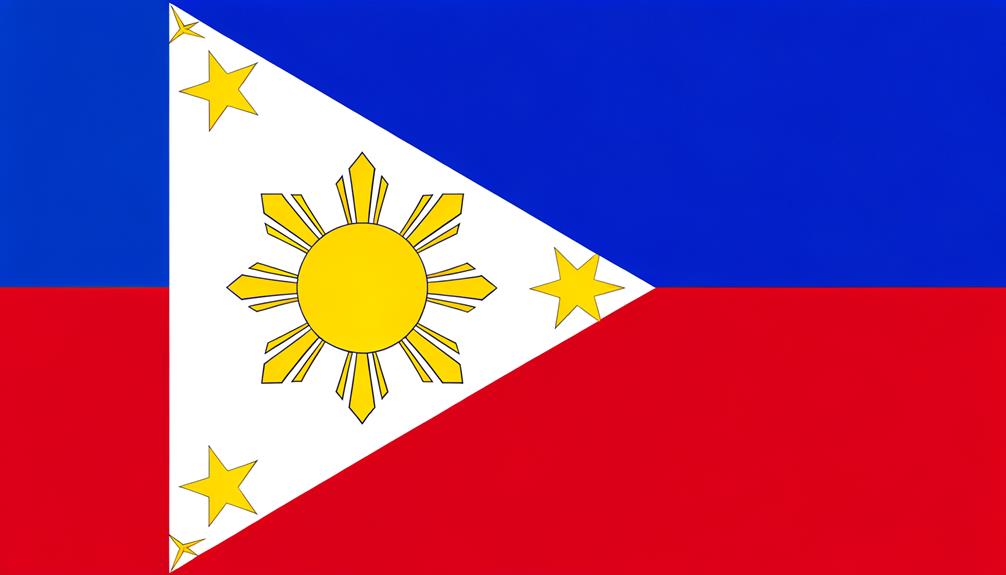What Are the Meanings of Philippine Flag Symbols in Tagalog?
The Philippine flag is a profound emblem of the nation's history and values. Blue signifies peace, truth, and justice, while red symbolizes courage and patriotism, reflective of historic battles.
White stands for purity and hope, framed in a triangle that denotes equality and fraternity, inspired by Masonic principles. The sun represents freedom and progress, with its eight rays commemorating the provinces pivotal in the 1896 Revolution.
The three stars epitomize Luzon, Visayas, and Mindanao, highlighting unity amidst regional diversity. Understanding these symbols offers a deeper appreciation of the Filipino spirit and historical journey.
Further study reveals even more nuanced meanings.

Key Takeaways
- Ang asul ay sumisimbolo ng kapayapaan, katotohanan, at katarungan.
- Ang pula ay kumakatawan sa tapang at pagmamahal sa bayan.
- Ang puting tatsulok ay simbolo ng pagkakapantay-pantay at pagkakaisa.
- Ang araw na may walong sinag ay naglalarawan ng pag-asa at kalayaan.
- Ang tatlong bituin ay kumakatawan sa Luzon, Visayas, at Mindanao, sumasagisag sa pambansang pagkakaisa.
Colors of the Flag

The colors of the Philippine flag—blue, red, white, and yellow—each hold significant historical and symbolic meanings that reflect the nation's struggles, ideals, and aspirations.
Blue symbolizes peace, truth, and justice, reflecting the nation's pursuit of harmony and equitable society.
Red represents courage and patriotism, honoring the sacrifices made by Filipinos during the revolution against Spanish colonial rule.
White stands for purity and hope, indicative of the people's aspirations for a just and fair society.
Finally, the yellow sun and stars represent freedom and independence, signifying the unity of the country's three major island groups: Luzon, Visayas, and Mindanao.
These colors collectively embody the rich historical tapestry and the enduring spirit of the Filipino people.
The Blue Field
Among the significant elements of the Philippine flag, the blue field stands out as a powerful symbol of peace, truth, and justice, serving as a constant reminder of the nation's enduring quest for harmony and equitable governance. Historically, the blue field was influenced by the American flag, reflecting the Philippines' aspirations for sovereignty and democratic ideals during its struggle for independence. The symbolism of the blue field has evolved, now embodying the Filipino people's collective hope for tranquility and moral integrity. Below is a table summarizing the key aspects of the blue field:
| Aspect | Description | Significance |
|---|---|---|
| Color | Blue | Represents peace and calm |
| Historical Influence | American Flag | Reflects democratic ideals |
| Symbolism | Peace, Truth, Justice | Embodies harmony and moral integrity |
| Evolution | From colonial aspiration to national identity | Reflects the transformation of national values |
This detailed representation underscores the blue field's enduring importance in Philippine symbolism.
The Red Field

The red field of the Philippine flag holds profound historical and symbolic significance, representing war victory and the valor of Filipino patriots. It signifies the courage and unwavering patriotism of those who fought in historic battles, such as the 1896 Philippine Revolution against Spanish colonial rule.
This element of the flag encapsulates the nation's enduring spirit of resistance and dedication to sovereignty.
Symbolizes War Victory
Representing the valor and sacrifices made during the nation's struggle for independence, the red field of the Philippine flag symbolizes the courage and bloodshed of Filipino revolutionaries in their quest for freedom.
The color red stands as a potent reminder of the numerous battles fought, particularly during the Philippine Revolution against Spanish colonial rule (1896-1898) and the subsequent Philippine-American War (1899-1902). This vivid hue is emblematic of the triumphs and losses endured on the path to self-determination.
Historically, the red field is also flown above the blue field in times of war, signifying an active defense of sovereignty. This practice underscores the steadfast resolve and unwavering spirit of a nation that has repeatedly risen to defend its liberty.
Represents Patriotism and Courage
Red, emblematic of the bloodshed and victories of Filipino revolutionaries, also stands as a powerful symbol of patriotism and unyielding courage in the face of adversity.
This vivid hue on the Philippine flag underscores the profound sacrifices made by those who fought for the nation's independence. It serves as a constant reminder of the valor exhibited during pivotal moments of resistance against colonial forces.
The red field is not merely a color; it encapsulates the collective resolve and bravery that fueled the quest for freedom. Therefore, it symbolizes the enduring spirit of Filipinos who, through generations, have demonstrated an unwavering commitment to defend their homeland and uphold its sovereignty at all costs.
Historical Significance in Battles
Embedded in the red field of the Philippine flag is a wealth of historical significance, particularly reflecting the critical battles fought during the nation's arduous struggle for independence.
This vibrant color symbolizes the valor and bravery of Filipino revolutionaries. The red field serves as a poignant reminder of the bloodshed and sacrifices made for the nation's sovereignty.
- Battle of Mactan (1521): Marked the first major resistance against Spanish colonization.
- Philippine Revolution (1896-1898): A pivotal uprising against Spanish rule, leading to the declaration of independence.
- Battle of Manila Bay (1898): A significant naval conflict that contributed to the end of Spanish control.
- World War II Resistance (1942-1945): Demonstrated Filipino resilience against Japanese occupation.
- People Power Revolution (1986): Symbolized modern-day nationalistic fervor and the fight for democratic restoration.
The White Triangle
The white equilateral triangle on the Philippine flag symbolizes equality and fraternity, reflecting the values espoused during the Philippine Revolution against Spanish colonial rule. Its design is steeped in Masonic influences, illustrating the unity and solidarity among the revolutionaries.
The triangle's shape represents a balance and unity, as each side is of equal length—a metaphor for the desired equality among Filipinos. Historically, this symbolism was pivotal in rallying support for independence, emphasizing collective effort and mutual respect.
The triangle also conveys fraternity, denoting the brotherhood and cooperation essential for achieving national goals. This emblematic feature underscores the fundamental principles that guided the nation's quest for freedom and remains a cornerstone of Filipino identity.
The Sun's Symbolism

The sun emblazoned on the Philippine flag is a potent symbol of hope and freedom, reflecting the nation's aspirations and struggles.
The eight rays emanating from the sun hold historical significance, representing the eight provinces that initiated the 1896 Philippine Revolution against Spanish rule.
This emblematic design element underscores the enduring spirit of resistance and the collective yearning for independence that defines the Filipino identity.
Eight Ray Representation
Representing the first eight provinces that revolted against Spanish rule, the eight rays of the sun on the Philippine flag symbolize the nation's early struggle for independence and the bravery of its people. This emblematic feature highlights the historical context of the Philippine Revolution, where these provinces became the vanguard of resistance:
- Manila: The heart of the uprising and administrative center under Spanish colonization.
- Cavite: Site of significant battles and birthplace of revolutionary leaders.
- Batangas: Known for fierce resistance and active participation in the Katipunan.
- Bulacan: A strategic location for revolutionary activities and insurgent assemblies.
- Pampanga: Contributed both manpower and resources to the revolutionary cause.
This symbolism immortalizes the unity and valor of those who fought for the nation's sovereignty.
Hope and Freedom
Radiating from the center of the Philippine flag, the sun's eight rays not only commemorate the revolutionary provinces but also symbolize the nation's enduring hope and quest for freedom. Each ray represents a province that was pivotal in the fight against Spanish colonial rule, embodying the resilience and unity of the Filipino people.
Historically, the sun's depiction reflects enlightenment, progress, and a new dawn for an emancipated nation. This symbolism is deeply rooted in the collective memory of the Filipino struggle for independence, serving as a reminder of past sacrifices and the ongoing pursuit of sovereignty.
The sun, hence, stands as a beacon of optimism and an emblem of the unyielding spirit of the Philippines.
The Three Stars
Embedded within the Philippine flag, the three stars symbolize the major geographical divisions of the country: Luzon, Visayas, and Mindanao. These stars represent not only territorial demarcations but also the unity and shared aspirations of the Filipino people. Introduced during the Philippine Revolution against Spanish colonization, the stars hold deep historical significance.
- Luzon: The largest and most populous island, a symbol of political and economic power.
- Visayas: Known for its rich cultural heritage and historical significance in pre-colonial trade.
- Mindanao: A land of diverse indigenous cultures and natural resources.
- Unity: The stars collectively symbolize national unity despite regional diversity.
- Resilience: They reflect the enduring spirit and resilience of the Filipino people throughout history.
Conclusion
To conclude, the Philippine flag's symbolism is deeply embedded in the nation's history and ideals. The blue field symbolizes peace and justice, while the red field represents courage and patriotism. The white triangle signifies equality and fraternity.
The sun, with its eight rays, symbolizes the initial eight provinces to rebel against Spanish rule. Surprisingly, 93% of Filipinos acknowledge the flag's elements, demonstrating a robust national consciousness and a collective grasp of the country's values and heritage.






